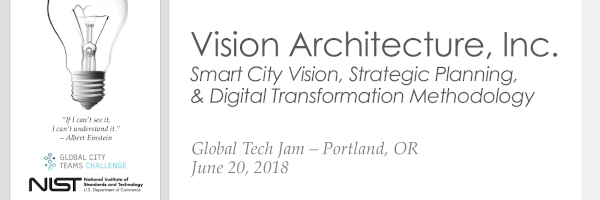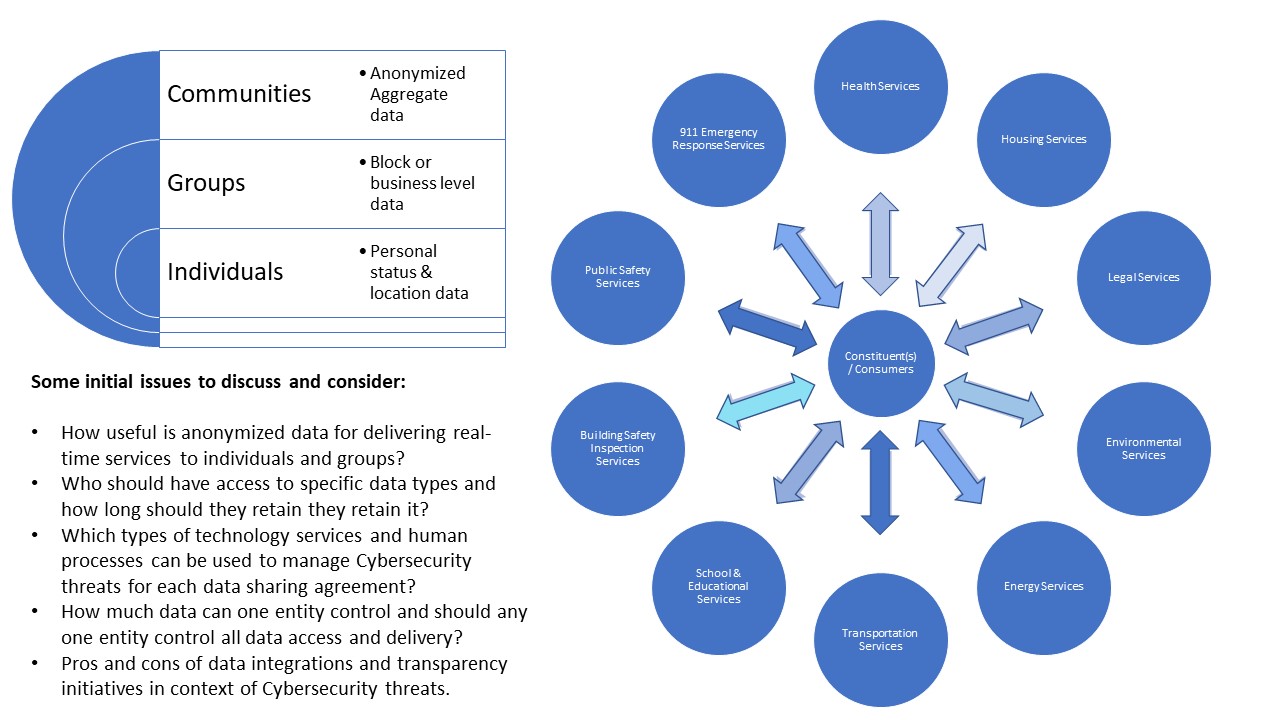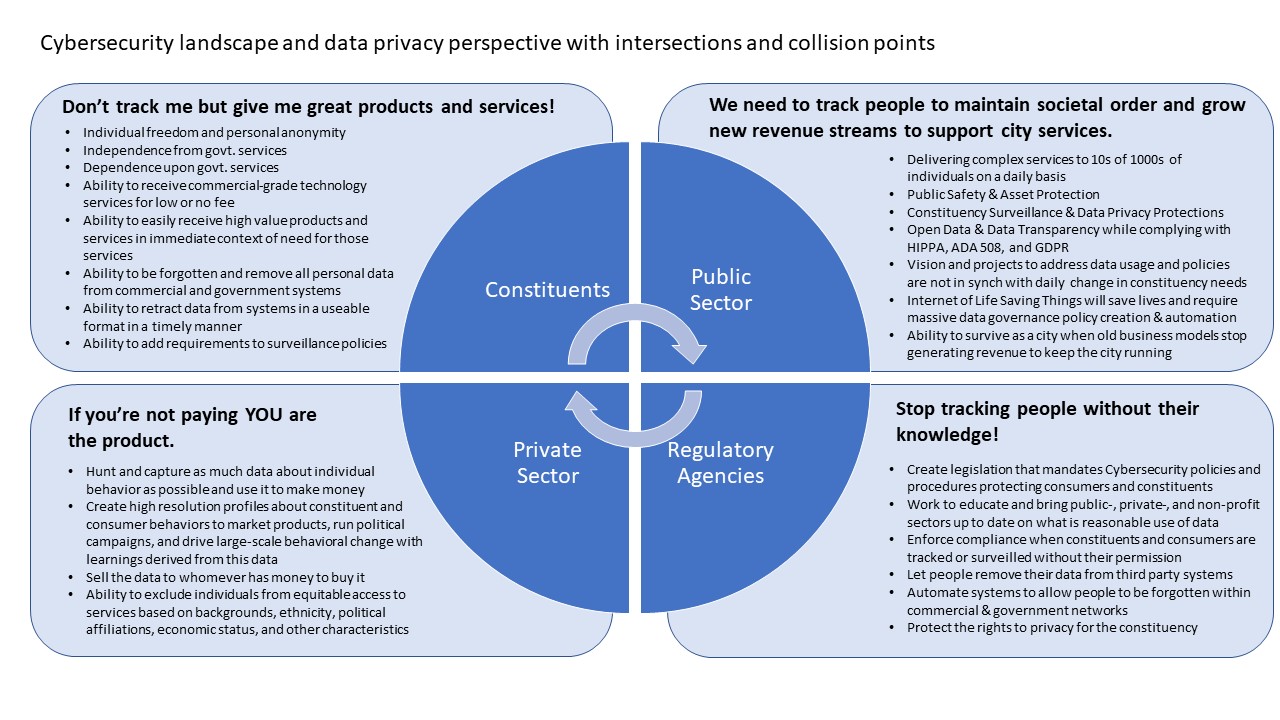Smart City Vision Strategic Planning and Digital Transformation Methodology
| Smart City Vision Strategic Planning and Digital Transformation Methodology | |
|---|---|

| |
 Smart City Vision, Strategic Planning, and Digital Transformation Methodology | |
| Team Organizations | Vision Architecture Metropolitan Intelligence SmartOakland Alameda County Healthy Homes Lead Poisoning Prevention Program Revalue.io West Oakland Environmental Indicators Project Rebuilding Together Oakland East Bay |
| Team Leaders | Stephanie Hayden |
| Participating Municipalities | Oakland CA San Francisco CA |
| Status | Launched |
| Document | 
|
Description
- The Smart City methodology helps people imagine and learn about future state scenarios for their lives, businesses, and cities. The process produces clearly defined product solutions and projects they want to create, design, and implement.
- The methodology can be used to introduce people who have little to no knowledge about Smart Cities and facilitate learning experiences that create and build well-versed leaders who can drive, manage, and support Smart City initiatives. Digital Transformation aspects will include key performance indicators and checkpoints to ensure teams remain on course until goals and future vision are realized.
- We are submitting this methodology for consideration and use with the Education SuperCluster and Action Teams to help define what each group would like to create for the SuperCluster and how they want to interface with the existing SuperClusters to integrate and amplify existing knowledge within the GCTC.
Challenges
- City governments do not have bandwidth, approval, or resources to reach outside predefined roles and responsibilities or be overly innovative or leading edge regarding Smart Cities and IoT projects. It’s not that they don’t want to work on new, exciting, high-value initiatives; they’re just not approved to work on things other than what taxpayers already voted for.
- Technology vendors have products and services to sell to cities but do not have the insight on the customer’s customer, the constituents, and mainly understand broad generalizations about what the public wants to see. Diverse constituencies do not fit in a normal sales life cycle and many of their needs go unheard for lack of time or resources.
- Constituents want more services, services that work, rapid responses, commercial-grade technology, and proactive services that are intelligence and tailored to them.
Solutions
These entities do not speak the same language or have the same sense of urgency for the other groups’ timelines. The Smart City Vision, Strategic Planning, and Digital Transformation Methodology can be used to gather requirements from all stakeholders, get them on the same page, design plans to implement solutions that everyone can understand, and move forward on Smart City initiatives. These workshops address the Current State, Future State, Digital Transformation Roadmap, and the metrics that will be used to measure performance and stay on track to meet their Smart City vision objectives.
Major Requirements
The Smart City Vision, Strategic Planning, and Digital Transformation Methodology is a 4-step methodology, framework, and set of workshops designed for people to quickly understand and figure out what they’re doing as individuals, and as a team, who should do what, and how they’ll work together from disparate locations to achieve goals doing the kind of work they like to do and feel like they’re contributing the highest value they can to the initiative.
ALFA WORKSHOPS
- create an inventory of the Current State of who, what, where, when, why, and how scenarios for what you're experiencing day to day. The goal is to create a mind map spectrum of insight that describes what is highly regarded, negative, positive, of net zero influence, in need of cancellation, taking a lot of time, being measured, not being measured, wild cards, and performance metrics being requested today.
BRAVO WORKSHOPS
- create an inventory of the Future State of who, what, where, when, why, and how scenarios of what you want to experience in the future. The goal is to create a mind map spectrum that describes highly regarded traits that will be most prominent in the future, the types of positive impact and influence that will be accessible, the performance over time that has brought stability and power to an individual and/or organization, and the metrics of success that brought this specific future to fruition.
CHARLIE WORKSHOPS
- create a line-by-line inventory of who, what, where, when, why, and how scenarios of for getting from the Alfa state to the Bravo state. This is where the conversations about data privacy, data capture, surveillance, and Cybersecurity come in because we understand how things are done today through the Alfa workshop and we know what is expected in the future through the Bravo workshop. Charlie defines explicitly Cybersecurity topics, policies, and procedures required to move to a new way of using data and doing business with it. The goal is to create a three-phase roadmap that describes specific steps and tasks that will be taken to detach from Alfa state processes and technologies that will not be beneficial or supported in the Bravo state. This workshop creates a large amount of information that describes 2-3 strategic plays and routes the individual and organization can use to traverse time and distance between Alfa and Bravo destinations.
DELTA WORKSHOPS
- use the output from GPS Alfa, Bravo, and Charlie to create a play-by-play navigation plan that describes exactly which who, what, where, when, why, and how scenarios will be used to reach the Bravo destination. The goal is to create explicit data metric targets and a scheduled timeline to hit the numbers and stay on course, on time, and on budget. This tight control of the environment and execution strategy allows the group to work independently and with assurance their moves and accomplishments are furthering the progress of the team without having to stop and check in very frequently to see if everyone is in alignment.
The outcome from these workshops can be reviewed as separate pieces owned by separate groups which when brought together create a clear picture of what Digital Transformation looks like for an organization or team. The final output is an illustrated roadmap and instructions about what each group needs to do from that point forward to reach their goals.
Performance Targets
| Key Performance Indicators (KPIs) | Measurement Methods |
|---|---|
|
We will measure our success using these Key Performance Indicators:
|
Standards, Replicability, Scalability, and Sustainability
The Smart City Vision, Strategic Planning, and Digital Transformation Methodology has been used in 50+ projects in public-, private-, and non-profit sectors where high-value outcomes include being able to receive and understand contextually specific data in scenarios where seconds make the difference between life and death, businesses using real-time data to grow new revenue streams and reduce costs, and disparately located project teams collaborating remotely to hone in on risks and opportunities that were not recognized before using the methodology.
Cybersecurity and Privacy
The Smart City Strategic Planning Methodology will include frameworks, checklists, and conversation starters to address data privacy and Cybersecurity issues for a broad range of stakeholder perspectives.
The Cybersecurity landscape and data privacy perspectives will showcase intersections and collision points where agenda is so different data privacy can become a show-stopper for Smart City projects. Our framework provides a way to keep the project moving by socializing varying agenda so all sides understand the benefits that come from defining new ways to share and secure data.
Impacts
For the GCTC Education SuperCluster
- Create the ability within the GCTC Education SuperCluster to organize each set of contributors, brainstorm as a group and come up with unified plans while identifying individual and group work streams, create approaches and solutions for each contributor to add the most value, determine who is responsible for which subject matter, and how each will reach out to produce and contribute what they’ve agreed to present. This will enable the SuperCluster to gain stable traction and grow momentum without overburden accumulating around any single contributor or leader. This will inspire other SuperClusters to share their information for inclusion with us and they will want to share our information with their membership – thereby growing strength in clarity and numbers for the GCTC.
For the Constituent-led, Public Data & IoT Utility for Urban Health, Housing, and Environmental Hazard Management Action Cluster
- The Smart City Vision, Strategic Planning, and Digital Transformation Methodology creates the ability within the constituency to organize, brainstorm, come up with a plan, create solutions, pitch for funding, and grow their own businesses to generate wealth for themselves and their families in their own communities using what they’ve learned to grow entrepreneurial independence and job skills in the Digital Economy.
- The economy will receive new business growth, community-based real estate development streams, and talent can be connected to local opportunities.
- A mentor/mentee program will be set up to provide Vision Architecture strategic vision and planning workshops for community members who want guidance, plans, and tools they can use to become the architects of their own futures.
For other GCTC Action Clusters
- If multiple SuperClusters and/or Action Clusters would like to join us at Oakland’s Civic Design Lab on the top floor of Oakland City Hall we can work together more frequently and share resources to build resilience and strength through local talent, entrepreneurs, and Public Sector leadership. We have offered this possibility and suggested hosting the GCTC’s newest SuperCluster for Education at Oakland City Hall to connect and collaborate in person with Bay Area stakeholders on a more frequent schedule to gain steam quickly.
Demonstration/Deployment
Regarding the GCTC Education SuperCluster
- We can show summaries of the process conducted with the GCTC Education SuperCluster as we would have deployed the toolsets amongst ourselves to help create a clear path forward for us. As another option we can share the results and timeline for SmartOakland using this method to collaborate with county officials on public health emergencies. As we reach out to other SuperClusters to determine how to include their insight into the knowledge network we can execute in unison as a well-oiled machine. Outside of the Education SuperCluster there is value in the toolset as global cities learn how to come online quickly, learn about Digital Transformations, and prepare to collaborate across time zones on real-time Smart City, data, and IoT projects.
Regarding the Constituent-led, Public Data & IoT Utility for Urban Health, Housing, and Environmental Hazard Management Action Cluster Action Cluster
- We can show summaries of the process conducted within the city of Oakland and the Bay Area where we used the Smart City to organize ourselves and what we’ve been able to accomplish as individuals and groups dynamically assembling to execute on plans and hit complex Smart City program targets.
- These examples will include initiatives already completed, those underway, and those planned for 2018-2020. Please refer to Constituent-led, Public Data & IoT Utility for Urban Health, Housing, and Environmental Hazard Management Action Cluster submission document for consideration of Action Cluster inclusion for 2018 GCTC cohort.
Regarding other Action Clusters
- If we collaborate with other Education SuperCluster team members and/or other Action Clusters we can show what was created and what resulted as well.
- We can also conduct either an Alfa, Bravo, Charlie or Delta workshop with a 12-person max at Tech Jam or the GCTC DC events, no fee. We may even be able to conduct one of each if time allows and interest exists for the overall GCTC to do in-person sessions during the next conference as well.

